|
|
 |
|
Cyclopoida ( Order ) |
|
|
|
Corycaeidae ( Family ) |
|
|
|
Corycaeus ( Genus ) |
|
|
|
Corycaeus ( Sub-Genus ) |
|
|
| |
Corycaeus (Corycaeus) vitreus Dana, 1849 (F,M) | |
| | | | | | | Syn.: | Corycaeus (Corycaeus) viretus : Tanaka, 1957 (lapsus calami, p.81, figs.M); Chen & al., 1974 (p.54, figs.M); Zheng & al., 1982 (p.135, figs.M); Guangshan & Honglin, 1984 (p.118, tab.); Shih & Chiu, 1998 (p.538); Go & al., 1997 (tab.1); Shih & Young, 1995 (p.76); Noda & al., 1998 (p.55, Table 3, occurrence);
C. crassiusculus : Farran, 1929 (p.211, 291, figs.F)
Corycaeus vitreus : Boxshall & Halsey, 2004 (p.494) | | | | Ref.: | | | F. Dahl, 1894 (p.73); M. Dahl, 1912 (p.25, Descr.M, figs.M); Farran, 1936 a (p.134, figs.F, Rem.); Dakin & Colefax, 1940 (p.111, figs.M, Rem.); Sewell, 1947 (Rem.: p.275); Motoda, 1963 (p.221, figs.M); Chihara & Murano, 1997 (p.967, Pl.218: M); | 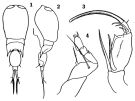 issued from : O. Tanaka in J. Fac. Agricult. Kyushu Univ., 1957, 11 (1). [Pl.4, Figs.1-4]. Male (from Japanese waters): 1, habitus (dorsal); 2, idem (lateral left side); 3, A2; 4, P4. Nota: Cephalothorax 1.5 times as long as urosome (26:17). The abdominal segments and furca in the proportional lengths 55:15:30. Anal segment is wider at the proximal than at the distal (13:11). Furcal rami 5 times as long as wide (19:4).
|
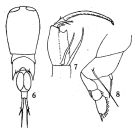 issued from : Q.-c Chen & S.-z. Zhang & C.-s. Zhu in Studia Marina Sinica, 1974, 9. [Pl.15, Figs.6-8]. As Corycaeus (Corycaeus) viretus. Male (from China Seas): 6, habitus (dorsal); 7, A2; 8, P4.
|
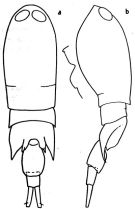 issued from : G.P. Farran in Great Barrier Reef Expedition 1928-29. Scientific Reports, V, No.3. Copepoda. 1936 [p.135, Fig.28]. Female: a, habitus (dorsal); b, idem (lateral left side). Nota: In form the female is more robust than C. crassiusculus. The urosome is shorter and broader in dorsal view, though scarcely differing when seen from the side; the furcal rami are noticeably broader and more tapered. There is a menbranous edge to the longest furcal seta, but it is narrow and tenuous and difficult to make out, and isequally present in the furcal seta of C. crassiusculus. Nota: The characters which separate it from the males of C.clausi and C. crassiusculus are the short cephalon, very broad in front and tapering posteriorly, the short anal segment and the fine transparent edge to the longest furcal seta
|
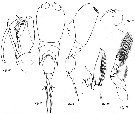 issued from : M. Dahl in Ergebnisse der Plankton-Expedition der Humboldt-Stiftung. Bd II, G. f1. I. Die Corycaeinen 1912. [Taf.III, Figs.8-13]. Male: 8, habitus (dorsal); 9, idem (lateral left side): 10, A2; 11, Mxp; 12, P1 (distal part of exopod 3); 13, P4.
|
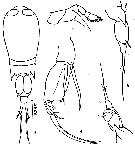 issued from : Z. Zheng, S. Li, S.J. Li & B. Chen in Marine planktonic copepods in Chinese waters. Shanghai Sc. Techn. Press, 1982 [p.136, Fig.84]. Male (from SE Korea): a, habitus (dorsal); b-c, urosome (lateral, right side); d, A2; e, P4. Scale bar in mm.
| | | | | Compl. Ref.: | | | Sewell, 1948 (p.393); C.B. Wilson, 1950 (p.197); Renon, 1987 (tab.2); Lo & al., 2004 (p.89, tab.1); Lan Y.-C. & al., 2008 (p.61, Table 1, % vs stations); | | | | NZ: | 5 | | |
|
Distribution map of Corycaeus (Corycaeus) vitreus by geographical zones
|
| | | | | | | Loc: | | | China Seas ( East China Sea, South China Sea), Taiwan, 25°30'N-122°30'E, Mienhua Canyon, Okinawa, Japan Sea, S Japan (Kuchinoerabu Is.), Japan (rare), Pacif. (W equatorial), Australia (Great Barrier, New South Wales), off New Zealand, off N Hawaii, Clipperton Is., Tuamotu Is. | | | | N: | 22 | | | | Lg.: | | | (34) F: 1,68; M: 1,7-1,62; (35) F: 1,74; M: 1,5; (104) M: 1,8; (107) M: 1,6-1,55; (109) M: 1,72; (667) M: 1,85-1,65; (1023) M: 1,56-1,7; {F: 1,68-1,74; M: 1,50-1,85} | | | | Rem.: | For Boxshall & Halsey (2004, p.491) the subgenus (Dahl, 1912) is considered as full generic status pending phylogenetic revision of the whole family at the generic level. | | | Last update : 18/05/2016 | |
|
|
 Any use of this site for a publication will be mentioned with the following reference : Any use of this site for a publication will be mentioned with the following reference :
Razouls C., Desreumaux N., Kouwenberg J. and de Bovée F., 2005-2025. - Biodiversity of Marine Planktonic Copepods (morphology, geographical distribution and biological data). Sorbonne University, CNRS. Available at http://copepodes.obs-banyuls.fr/en [Accessed October 24, 2025] © copyright 2005-2025 Sorbonne University, CNRS
|
|
 |
 |








